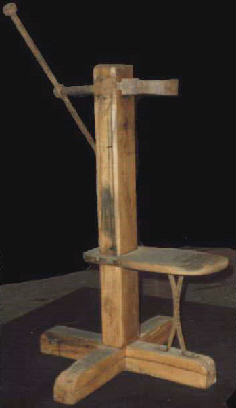|
The garrote. |
The garrotte (or garrote) was the standard
civilian method of execution in Spain. It was introduced in 1812/13, at the
beginning of the reign of Ferdinand
Some 96 people, including two women, were
garrotted between 1900 and 1935 with a further 110 men and three women being
put to death in the post Civil War period.
Executions also took place by shooting during this period and Spain’s
last executions were by firing squad.
Shooting was more commonly handed down by military tribunals, however,
it is unclear why people were shot for civilian murders. Most 20th century executions were for murder
or terrorist related crimes, although banditry remained a capital crime,
certainly into the 1950’s.
Sixty five men and two women were executed by garrotte
between 1950 and 1974 in various parts of
 Garrotting
appears to have developed from the early Chinese form of execution known as the
bow-string. The criminal was tied to an upright post with two holes bored in it
through which the ends of a cord from a long bow were passed and pulled tight
round the neck by the executioner until the condemned strangled. In the original Spanish version, the prisoner
was seated on top of a short post with his back to the main post and a rope
loop was placed round his neck and around the post. The executioner twisted a
stick inserted in the loop to tighten the rope and strangle the prisoner.
Garrotting
appears to have developed from the early Chinese form of execution known as the
bow-string. The criminal was tied to an upright post with two holes bored in it
through which the ends of a cord from a long bow were passed and pulled tight
round the neck by the executioner until the condemned strangled. In the original Spanish version, the prisoner
was seated on top of a short post with his back to the main post and a rope
loop was placed round his neck and around the post. The executioner twisted a
stick inserted in the loop to tighten the rope and strangle the prisoner.
As in most countries, a more humane method of execution was sought and various
improvements to the garrotte were made.
The next form of garrotte comprised a wooden stool on which the prisoner sat
with his back to the post (pictured). In some later instances a strong wooden
chair was used. The condemned was
strapped at the wrists, arms, waist and legs and the hinged iron collar closed
around their neck. A screw operated by a handle or a weighted lever connected
to a spike or a small star shaped blade ran through the post. When the
screw/lever mechanism was operated, the blade entered the criminal's neck and
severed the spinal column, in an attempt to ensure that the prisoner did not
strangle to death.
In some versions, two brass collars were used. One collar was attached to the
lever whilst the other was fixed to the post. Both collars were hinged to admit
the prisoner's neck. When all preparations were complete, the executioner
operated the mechanism forcing one collar outwards whilst the other remained
stationary thus, if correctly adjusted, dislocating the prisoner's neck and
causing immediate unconsciousness followed by death. (As in modern hanging). Click here for a photo
of a 20th century garrotting in
An execution by garrotting of a robber named Jose de Roxas in
A convulsive pressure of the hands and a heaving of the chest were the only
visible signs of the passing of the robber's spirit. After a pause of a few
seconds, the executioner peeped behind the cloth and after giving another turn
to the screw, removed the cloth. The dead man was slightly convulsed, the mouth
open and the eyeballs were turned into their sockets.
This description is very similar to those of executions carried out by hanging
at the same period. In most cases, the
prisoner lost consciousness quite quickly and was dead after a few minutes.
Garrotting, even in its later forms, could never guarantee an instant loss of
consciousness and was never considered to be as quick or humane as hanging.
The first woman to be garotted was Juana Rivero in
The last female garrotting took place on
Garrotting was last used on the 2nd of March 1974, when two men were
executed on the same day. Salvador Puig Antich was put to death in
I am told that the last Spanish executions (in 1975) could not use this method
because of a bureaucratic problem. At this time in
The garrotte was used in Spanish colonies, e.g.
With special thanks to my friend Christian
Schrepper for allowing me to publish the results of his research into Spanish
executions.
Click here for a
unique listing of Spanish executions since 1812.
Back to Contents page Listing of Spanish
executions from 1812.